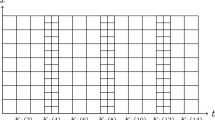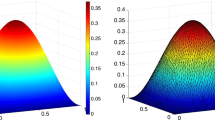Summary
We extend in this paper the analysis of a posteriori estimates of the space discretization error presented in a previous paper [3] for time-independent space meshes. In the context of the model problem studied there, results are given relating the effectiveness of the error estimator to properties of the solution, space meshes, and manner in which the meshes change. A procedure based upon this theory is presented for the adaptive construction of time-dependent meshes. The results of some computational experiments show that this procedure is practically very effective and suggest that it can be used to control the space discretization error in more general problems.
Similar content being viewed by others
References
Babuška, I., Rheinboldt, W.: A posteriori error analysis of finite element solutions of onedimensional problems. SIAM J. Numer. Anal.18, 565–589 (1981)
Babuška, I., Rheinboldt, W.: Analysis of optimal finite element meshes in ℝ1. Math. Comput.33, 435–463 (1979)
Bieterman, M., Babuška, I.: The finite element method for parabolic equations, I. A posteriori error estimation. University of Maryland I.P.S.T. Technical Note BN-983, 1982 (to appear)
Bieterman, M.: Ph.D. Thesis, University of Maryland, 1982
Bonnerot, R., Jamet, P.: Numerical computation of the free boundary for the two-dimensional Stefan problem by space-time finite elements. J. Computational Phys.25, 163–181 (1977)
Davis, S., Flaherty, J.: An adaptive finite element method for initial-boundary value problems for partial differential equations. ICASE Report 81-13, NASA Langley Research Center, Hampton, Virginia, 1981. SIAM J. Sci. Stat. Comput.3, 6–27 (1982)
Douglas, J. Jr., Dupont, T.: Galerkin methods for parabolic equations. SIAM J. Numer. Anal.7, 575–625 (1970)
Dupont, T.: Mesh modification for evolution equations. Math. Comput.39, 85–108 (1982)
Gannon, D.: Self-adaptive methods for parabolic partial differential equations. Ph.D. Thesis, University of Illinois, Urbana-Champaign, 1980
Gelinas, R.J., Doss, S.K., Miller, K.: The moving finite element method: applications to general partial differential equations with multiple large gradients. J. Computational Phys.40, 202–249 (1981)
Jamet, P.: Galerkin-type approximations which are discontinuous in time for parabolic equations in a variable domain. SIAM J. Numer. Anal.15, 912–928 (1978)
Lions, J.L., Magenes, E.: Nonhomogeneous boundary value problems and applications I and II. Berlin, Heidelberg, New York: Springer 1973
Miller, K., Miller, R.: Moving finite elements I. SIAM J. Numer. Anal.18, 1019–1032 (1981)
Miller, K.: Moving finite elements II SIAM J. Numer. Anal.18, 1033–1057 (1981)
Author information
Authors and Affiliations
Additional information
The work was partially supported by ONR Contract N00014-77-C-0623
Rights and permissions
About this article
Cite this article
Bieterman, M., Babuška, I. The finite element method for parabolic equations. Numer. Math. 40, 373–406 (1982). https://doi.org/10.1007/BF01396452
Received:
Issue Date:
DOI: https://doi.org/10.1007/BF01396452




